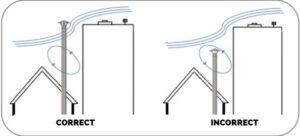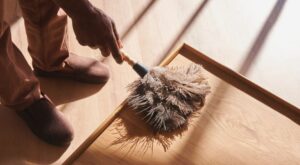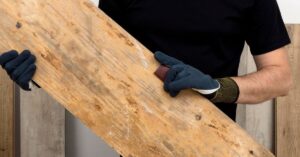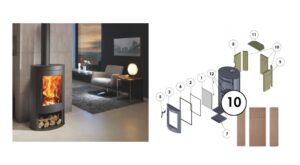
Although we enjoy the warmth of the fireplace, the odors can be unpleasant. With simple tricks like vinegar, salt, or baking soda, you can keep your home fresh and cozy.

If you are thinking of installing a fireplace or wood stove in your home or you have problems with the pipes of your current appliance… You are in luck!
We explain you how the correct position of the pipes of a fireplace should be. Although it may seem a minor detail, it is very important that they are placed in the right way. This will ensure proper smoke evacuation and avoid safety problems.
We will also answer questions such as: Why is the position of the chimney pipes important? What is the correct position for the chimney pipes? What happens if the chimney pipes are incorrectly positioned? And many more questions.
We hope you find this post useful!
Chimney pipes must be positioned correctly to avoid safety problems and to ensure correct evacuation of combustion gases.
It is true that, until a few years ago, there was less awareness of double-wall flues. Most stoves and fireplaces were installed with very simple pipes. This resulted in many condensation and smoke plaster problems.
At Panadero, as manufacturers of stoves and fireplaces, we always recommend that the pipes installed on the outside be double walled or insulated. This avoids condensation problems that result in soot falling through the pipe joints and possible blockages in the stove.
It is essential that professionals and installers are well informed about how to install the pipes. In addition, they should know all about these double-walled tubes, where to place them and how to install them.
First of all, the chimney pipes should be positioned so that they are as vertical as possible. It is important to go through walls or partitions with 45° bends. In addition, horizontal runs and 90° bends should be avoided at all costs, as they cause flue gases and clog the flues.

Pipes should be at least 3 linear meters long to prevent combustion gases from accumulating inside.
In addition, it is important that there is sufficient space between the pipes and any nearby obstacles, such as the roof or walls of the house, to ensure proper air circulation. We recommend that the outside outlet should exceed the highest part of the roof by at least one meter. If there is an obstacle within a radius of 5 meters (e.g. trees, buildings or houses), this outlet should be at least 1 meter above this obstacle. In addition, this outlet must have an anti-roofing cap.


The chimney pipes must be sealed to prevent flue gases from escaping through the joints. It also ensures proper smoke evacuation.
It is necessary to use special chimney sealants that are heat resistant and do not melt or release smoke at high temperatures. A good example of a refractory sealant is refractory silicone. You can easily find this type of product at your local DIY store or hardware store.
Read more about tube sealing and how to perform this sealing by clicking here.
The reduction is an accessory used to adapt the diameter of the chimney or stove flue to a smaller size. However, it is not recommended to put a reduction on the flue of a wood stove.
Why is it not recommended? We, as manufacturers, design and calculate stoves for one flue diameter. If it is reduced, we will have problems of flue gas overflow in the combustion chamber and the appliance may overheat and, therefore, break down.
In addition, using reductions in the stove flue may void the manufacturer’s warranty and cause the stove to fail to comply with safety regulations.
If the chimney pipes are improperly positioned, safety problems can occur. For example, fires or explosions due to the accumulation of flue gases.
In addition, poorly positioned pipes reduce the efficiency of the chimney and make it less effective in heating the house.
In summary, it is very important to know the correct position of the chimney pipes. They are one of the fundamental bases for the proper functioning of our stove or fireplace. In addition, a correct installation of the pipes translates into safety in our home and efficiency of the appliance.
As points to emphasize, the pipes must be placed as vertical as possible, with 45º elbows. It is necessary and of obligatory fulfillment, that there is a sufficient space between the tubes of the smoke outlet and any obstacle, to guarantee a correct circulation of the air.
It is also necessary to use special chimney sealants to seal joints and seams. Refractory silicone is a very resistant material used for this purpose.
It is not recommended to use reductions in the stove flue, as they can obstruct the exit of combustion gases, reduce the efficiency of the stove and void the manufacturer’s warranty.
In our blog you will find more tips on the installation and use of fireplaces and wood stoves. We encourage you to read our posts and consider purchasing one of our high quality wood stoves, we are sure you will not be disappointed!
Articles of interest:
Did you like this article? If so, help us spread it ???? . Click on the buttons below here and feel free to share it on your social networks!
Thank you for reading!
↓ ↓ ↓ ↓

Although we enjoy the warmth of the fireplace, the odors can be unpleasant. With simple tricks like vinegar, salt, or baking soda, you can keep your home fresh and cozy.

How to avoid dust in the house when using a wood stove: tips and tricks for a clean and healthy home

Learn how to remove mould from your wood for use by following the steps in this article.

All you need to know: what it is, uses and benefits of wood stoves
To provide the best experiences, we use technologies such as cookies to store and/or access device information. Consenting to these technologies will allow us to process data such as browsing behavior or unique identifiers on this site. Not consenting or withdrawing consent may adversely affect certain features and functions.

From December 19 to January 6, order a wood stove and receive the Helix log holder for free.